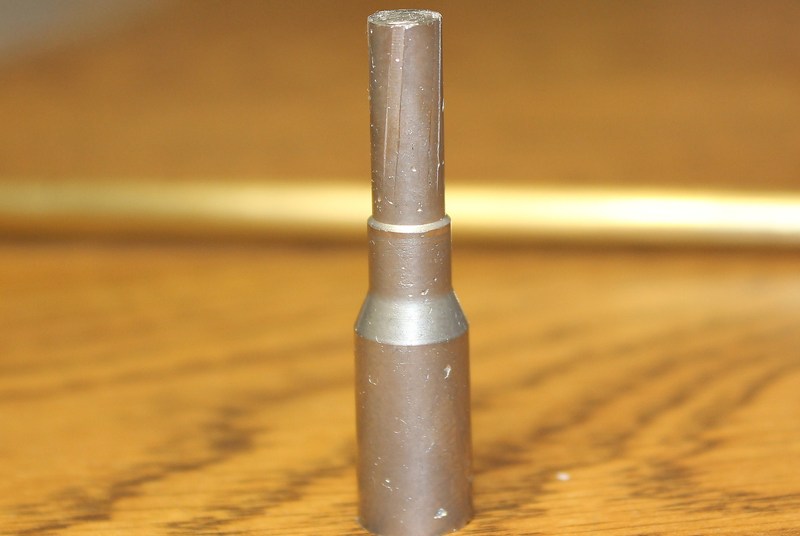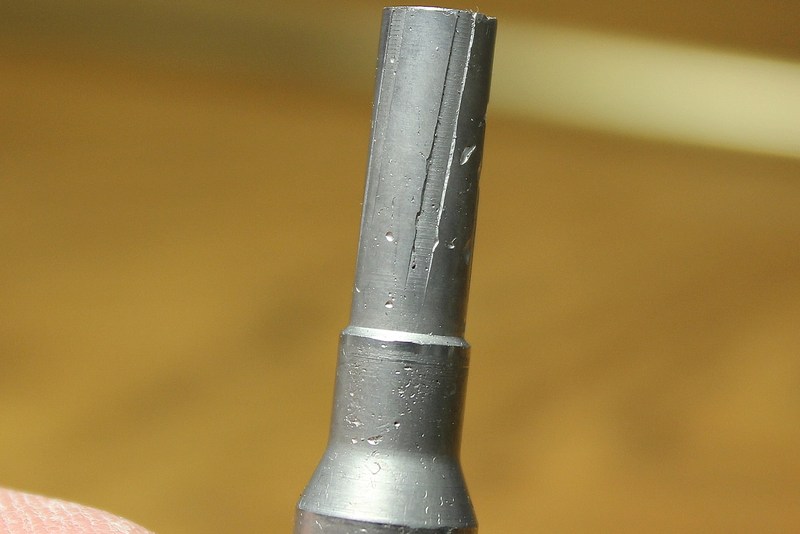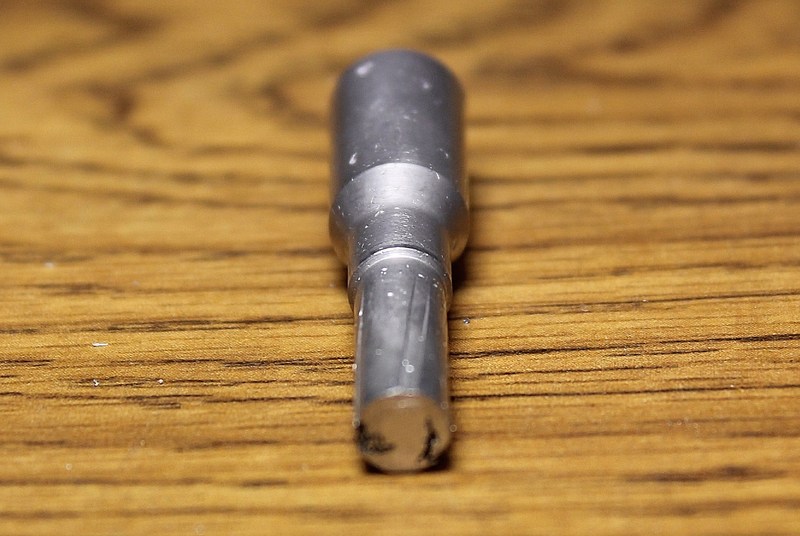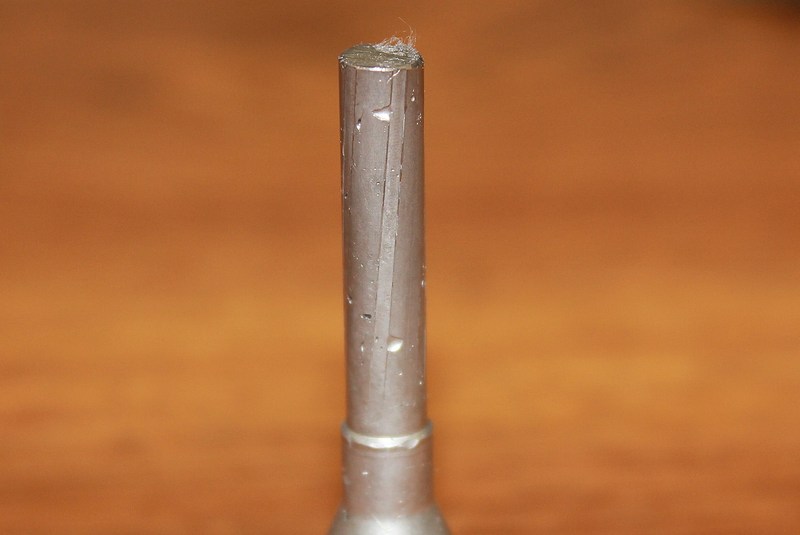
 |
|
|||||||
| Forum Rules | Firearms Safety | Firearms Photos | Links | Library | Lost Password | Email Changes |
| Register | FAQ | Calendar | Today's Posts | Search |
 |
|
|
Thread Tools | Search this Thread |
|
|
#1 |
|
Senior Member
Join Date: April 10, 2012
Location: San Diego CA
Posts: 6,875
|
Casting chamber and throat area ???
This is a cast of my 223 wylde 5r chamber, throat and a little of the bore .
      The casting went well with no real issues . I had more bubbles in the cast then I would have liked but I think it will work . The first thing I learned was I had no idea what and or how to measure the cast . As soon as I started measuring I realized I had no idea what I was doing . The whole point of this was to measure the groove depth . The back side of my calipers are to fat to fit inside the land/groove . Here are the numbers I came up with , Please tell me what they mean , if anything at all ? These are the measurements of the cast Chamber neck area .257 Chamber just below the shoulder .359 Outside bore area .2250 Inside bore area .2225, only measuring one land do to there not being another opposite side of bore Bullet size is Hornady 75gr match .2245 Sierra 77gr MK .2255 and .2245 from two different boxes What does all this mean to me and what bullet should i use ? I think I know a little of what's going on here but instead of saying something and looking really stupid . I'll wait and see what you guys say
__________________
If Jesus had a gun , he'd probably still be alive ! I almost always write my posts regardless of content in a jovial manor and intent . If that's not how you took it , please try again .  
Last edited by Metal god; August 19, 2014 at 03:09 PM. |
|
|
|
|
#2 |
|
Senior Member
Join Date: February 15, 2009
Posts: 8,927
|
Match grade 22 caliber barrels are typically .2180" bore and .2240" groove. Anything larger is often hard to shoot extremely accurate with. Bullets need to be a few .0001's inch larger than groove diameter for best accuracy. So use the .2255" diameter ones in your barrel.
I'm suprized Sierra's bullets have that much difference. |
|
|
|
|
#3 |
|
Senior Member
Join Date: April 10, 2012
Location: San Diego CA
Posts: 6,875
|
This was not sold as a match barrel . This is a AR stoner barrel from Midway USA . After doing some research on this barrel it seems that Midway gets them from ER-shaw . That's why I call it a ER-shaw barrel . After looking at the cast . If it is from ER shaw it's there factory seconds . If you look at the land groove you can see the chatter marks from what ever they used to cut/drill the bore hole . I assume those should be smooth rather then bumpy . You can see them pretty good in the 3rd pic
My .225 groove measurement was kind of a loose measurement . Meaning I did not check one or two spots and average . I spun the cast while in the calipers and recorded the largest measurement . If I just measured one spot it was often .2240 to .2245 . It's hard to measure though . There is always a land opposite the groove with the 5r bore so getting the calipers in just the right spot is difficult . As for the lands . That was even harder . My eyes are not that good and the land was a very small area to get the calipers in . The fact I was only able to measure one land at a time do to the opposite side of the bore issue . I'm less sure about that measurement then the other . I was getting just as many .2220 as I was getting .2225 .I picked the largest number recorded at each measurement . Considering that's just one side . I could be off a total .001 on that measurement . Maybe I try it again and ask my retired tool maker step father to come over and help me measure . He has all kinds of different types of measuring tools . He may even know what he's doing and how to use them 
__________________
If Jesus had a gun , he'd probably still be alive ! I almost always write my posts regardless of content in a jovial manor and intent . If that's not how you took it , please try again .  
Last edited by Metal god; August 20, 2014 at 02:24 AM. |
|
|
|
|
#4 |
|
Moderator Emeritus
Join Date: June 25, 2008
Location: Austin, CO
Posts: 19,578
|
When you're concerned with fractionals of thousandths of an inch, calipers are not sufficient for the task. You need micrometers and a v-anvil (or similar) to measure the rifling.
__________________
Nobody plans to screw up their lives... ...they just don't plan not to. -Andy Stanley Last edited by Brian Pfleuger; August 19, 2014 at 02:35 PM. |
|
|
|
|
#5 | |
|
Senior Member
Join Date: December 24, 2008
Location: Loveland, CO
Posts: 1,476
|
Quote:

__________________
NRA Benefactor Life member |
|
|
|
|
|
#6 |
|
Senior Member
Join Date: April 10, 2012
Location: San Diego CA
Posts: 6,875
|
I think we got it . . Step dad came over with his tools and we got .2250 groove and .2190 lands . This really concerns me . I measured the bullets I have here and none are more then .2245 . I must have measured that one SMK box wrong . Bart is implying that the bullet needs to contact the groove just barely for best accuracy . None of the bullets I have will . I have some cheap bullets that measure .2240 . Sounds to me those would just rattle down the barrel and tumble to the target
 . OK maybe not that bad . OK maybe not that bad  but is there a match bullet and or company that tends to make there bullets a tad bigger in diameter . Not sure how much this matters to me right now . This rifle will be for shooting NRA service rifle competition . The last time I shot irons at 200yds off hand my group but is there a match bullet and or company that tends to make there bullets a tad bigger in diameter . Not sure how much this matters to me right now . This rifle will be for shooting NRA service rifle competition . The last time I shot irons at 200yds off hand my group patern was 9 moa . If I'm going to loose 1/4 moa or a little more of accuracy using this barrel . Not sure I'll ever see it before I shoot it out . patern was 9 moa . If I'm going to loose 1/4 moa or a little more of accuracy using this barrel . Not sure I'll ever see it before I shoot it out . With a .224 bullet and a .225 groove . Is it possible gases slip by the bullet while in the barrel ?
__________________
If Jesus had a gun , he'd probably still be alive ! I almost always write my posts regardless of content in a jovial manor and intent . If that's not how you took it , please try again .  
|
|
|
|
|
#7 |
|
Senior Member
Join Date: July 1, 2013
Location: Douglasville, Ga
Posts: 4,615
|
ive never caste a chamber, so I don't know what you use, but is it possible for the {polymer,epoxy...whatever} to shrink a couple hundredths as it cures?
__________________
My head is bloody, but unbowed |
|
|
|
|
#8 |
|
Senior Member
Join Date: February 15, 2009
Posts: 8,927
|
All chamber casting stuff shrinks a little, then usually expands a little bit. Cerrosafe was popular and gave accurate numbers when its directions were followed: The following mentions the errors readings will have if not followed:
http://www.csalloys.com/products-cerrosafe-alloy.html So, if your casting material's directions for accurate readings were followed, your numbers will be correct if properly measured. Jacketed bullets expand to fill groove diameters larger than they are near instantly when fired. The more they have to expand, the less uniform they'll be when they are and fill the grooves. Swaging them down a few to several tenths does so very uniformly in smaller groove diameters. Lapua's .3092" diameter bullets have shot 1/6 MOA at 600 yards from .3077" groove diameter barrels. Sierra's new Palma bullets at .3084" diameter shot about 1/2 MOA at 600 yards in barrels with .3065" to .3080" groove diameter groove. Nobody I know of gets supreme accuracy shooting jacketed bullets smaller in diameter than their barrel's groove diameter. Last edited by Bart B.; August 21, 2014 at 07:03 AM. |
|
|
|
|
#9 |
|
Senior Member
Join Date: April 10, 2012
Location: San Diego CA
Posts: 6,875
|
 We did a new better and longer cast( pic above ) and did in deed follow the directions . We measured exactly one hour after casting for about 5 to 10 minutes . We then measured the first cast I did 24hrs earlier and it had grown .001 at all measurements not the .0019 it was supposed to in the 24hr period after . We assumed this was do to how small the cast is . I'm thinking if the cast was of a 50 BMG or bigger the cast would expand more . I'll be breaking the barrel in on saturday but will not have any match ammo with me so I won't know how it really shoots yet . I might pick up a box and throw a scope on it real quick but really just going to check function of the rifle . I assume the lead/throat is the smooth part after the chamber and before the lands start ?? You can see this area best in the 3rd pic at the top of thread
__________________
If Jesus had a gun , he'd probably still be alive ! I almost always write my posts regardless of content in a jovial manor and intent . If that's not how you took it , please try again .  
Last edited by Metal god; August 21, 2014 at 10:30 AM. |
|
|
|
|
#10 |
|
Senior Member
Join Date: February 15, 2009
Posts: 8,927
|
Why are you planning on breaking in the barrel? Was something wrong with it when new? It starts wearing out by roughing up the throat and leade starting with the first shot fired.
|
|
|
|
|
#11 | |
|
Moderator Emeritus
Join Date: June 25, 2008
Location: Austin, CO
Posts: 19,578
|
Quote:
By the way, life a lot easier with that stuff if you put a plastic syringe in hot water and then use it to suck up the molten Cerrosafe. You can then inject the CerroSafe directly into your chamber. It's also best to heat the chamber up to CerroSafe melting point and allow it to cool slowly. That will avoid the "frosty" appearance and give ou more time to get the stuff in there too. Tap the sides of the chamber as you fill it to avoid those air pockets.
__________________
Nobody plans to screw up their lives... ...they just don't plan not to. -Andy Stanley |
|
|
|
|
|
#12 |
|
Senior Member
Join Date: August 25, 2008
Location: In the valley above the plain
Posts: 13,424
|
Many reloaders, gunsmiths, gun owners, bullet casters, etc. will debate exactly what a "throat" is, and exactly what a "leade" is.
But, generally, the most technically correct and accepted concept would be: I hope you don't mind that I used a screen-grab of your image. I'll gladly delete it, if you take offense.
__________________
Don't even try it. It's even worse than the internet would lead you to believe. |
|
|
|
|
#13 |
|
Senior Member
Join Date: April 10, 2012
Location: San Diego CA
Posts: 6,875
|
I will not be doing a "full" break in . The fact this was not sold as a match barrel and I'm sure it was not lapped . I'd like to do a 12 to 16 shot break in . 1 shot clean for the first five shots or so . Then two 3 shot and clean strings with one last 5 shot string . My thought on this as well is I can be checking function at the same time . The first few shots are going to be one at a time anyway . Why not run a few patches through while I'm at it .
As for the pic showing the leade . I'd think that would stop right at where the lands start and not 1/2" into the bore ???
__________________
If Jesus had a gun , he'd probably still be alive ! I almost always write my posts regardless of content in a jovial manor and intent . If that's not how you took it , please try again .  
|
|
|
|
|
#14 |
|
Senior Member
Join Date: February 15, 2009
Posts: 8,927
|
I'd forget about breaking it in. Only the very worst finished bores in barrels ever need any breaking in, in my opinion. They need a hundred or more shots to do it. By then, their rifling origin has worn a bit and the sharp edges of the rifling are irregularly rounded. If you have to break in a barrel, its accuracy won't be anything spectacular anyway.
|
|
|
|
|
#15 | |
|
Senior Member
Join Date: August 25, 2008
Location: In the valley above the plain
Posts: 13,424
|
Quote:
In the case of your .223 Wylde chamber (.225 groove/freebore and .219 bore), the taper of the leade should be approximately 0.275" long. ...which is almost right on for the eye-balled location I marked in the image.
__________________
Don't even try it. It's even worse than the internet would lead you to believe. |
|
|
|
|
|
#16 | |
|
Senior Member
Join Date: February 15, 2009
Posts: 8,927
|
Quote:
For example, SAAMI's glossary for "throat" and "leade" says it's That section of the bore of a rifled gun barrel located immediately ahead of the chamber in which the rifling is conically removed to provide clearance for the seated bullet. Also called Throat or Ball Seat. Most 'smiths and reamer people I've talked with about this issue say the throat is the distance from the chamber "mouth" (that part of the chamber that's in the same relative place as the case mouth) that's a bit larger than bullet diameter to the point where the origin of the rifling angle starts down to bore diameter. In the following SAAMI drawing: http://www.saami.org/PubResources/CC...Winchester.pdf its the .310" diameter dimension from the chamber drawing's "tiny shoulder" at its front to .0900" forward where the rifling angle starts 2.1388" forward of the bolt face. The chamber mouth has a 35.72 deg. angle from the chamber neck diameter to the throat diameter. Its throat is half an inch or so longer when 240-gr. HPMK bullets are used so a 42 to 43 grain charge of IMR4350 can be put below the bullet base without crushing any of its kernels. Some cartridge specs show no throat at all as the leade angle starts at the chamber mouth. The "leade" starts 2.1388" forward of the bolt face angling down at a 1.75 deg. angle to bore diameter. That's what reamer maker grind that part of the reamers to and they typically call it the "leade angle." SAAMI doesn't make this distinction which further muddies the water this issue needs to be seen clearly through. Their standards are voluntary by companies subscribing to them. Last edited by Bart B.; August 21, 2014 at 03:51 PM. |
|
|
|
|
|
#17 |
|
Senior Member
Join Date: April 10, 2012
Location: San Diego CA
Posts: 6,875
|
UPDATE
So I got the rifle together and have/had it running good . I put a total of 150 rounds through the barrel with 4 different bullets and two different powders M193 ball and some of my reloads ) . I broke the whole upper back down and made another cast of the chamber and throat/bore .   I wish I had put more through the rifle but was only doing a function test . This will be likely the last casting I do for quite awhile . At a glance it seems the chatter on the lands is just about gone and all the sharp edges are a bit more rounded . Hope that means the rifle is about to settle in and start shooting really well . Best I did at 100yds was 1.2 moa . I had some flyers (uncalled ) and if not for those I would have shot .4 / .6 and .8 moa groups during load development . On a none match barrel should I be doing load development before I even have 100 rounds through the rifle . I got to thinking maybe I should put at least 2 or 3 hundred down the pipe first to let the bore settle in . I built an AR for my dad a few months ago and IMHO it is shooting better now (500rds later) then it did the first day we took it out (accuracy wise ).
__________________
If Jesus had a gun , he'd probably still be alive ! I almost always write my posts regardless of content in a jovial manor and intent . If that's not how you took it , please try again .  
Last edited by Metal god; August 31, 2014 at 12:12 AM. |
|
|
|
|
#18 |
|
Senior Member
Join Date: February 15, 2009
Posts: 8,927
|
As the rifling wears away the land's square/sharp edges start rounding off and metal surfaces get rough, accuracy gets worse. All barrels start wearing out starting with the first round fired. How much may be hard to tell. Few people see an accuracy difference across a couple hundred rounds.
Black Hills(?) did a test with their .308 Win. match ammo some years ago testing 5-shot groups at 100 yards. Starting out with groups averaging about 1/4 inches, they averaged about 3/8 inches after 3000 rounds. At 5000 rounds, the average went to 5/8 inch, or somthing like that and at 7000 to 8000 rounds, groups were in the 7/8 inch range. Sierra Bullets' .308 Win test barrels behave the same way, but they're considered worn too much for accuracy testing after their group averages go over about 3/8 MOA at 200 yards. They start out in the 1/4 MOA range with good lots of match bullets. Uncalled fliers are part of the group; don't toss them out because they reflect the accuracy of the worst rounds loaded. I encourage folks to forget the smallest groups they shoot. For a given lot of ammo, there's all sorts of variables in it. When they cancel each other out, the groups are very small. When the all add up in all directions, the groups are the largest. You can count on all groups fired being smaller than the largest one fired. Likewise, you can also count on all groups fired being larger than the smallest one fired. Which groups best represent the accuracy of the ammo? Last edited by Bart B.; August 31, 2014 at 05:04 AM. |
|
|
|
|
#19 | |
|
Senior Member
Join Date: April 10, 2012
Location: San Diego CA
Posts: 6,875
|
Quote:
__________________
If Jesus had a gun , he'd probably still be alive ! I almost always write my posts regardless of content in a jovial manor and intent . If that's not how you took it , please try again .  
|
|
|
|
|
|
#20 |
|
Senior Member
Join Date: February 15, 2009
Posts: 8,927
|
What was the largest group for each load?
|
|
|
|
|
#21 |
|
Senior Member
Join Date: April 10, 2012
Location: San Diego CA
Posts: 6,875
|
There was only one group per load . Next trip I'll shoot two 5 shoot groups with the same point of aim giving me a 10 shot group .Then I'll do one 10 shot continues group of the same load . I'll do this for each load that shot well the first time out . This in the past has really narrowed down whats really shooting well in my rifles .
__________________
If Jesus had a gun , he'd probably still be alive ! I almost always write my posts regardless of content in a jovial manor and intent . If that's not how you took it , please try again .  
|
|
|
|
|
#22 | |
|
Senior Member
Join Date: April 10, 2008
Location: Alaska
Posts: 7,014
|
Quote:
On the other hand, there is probably a lot of us who delight in our smallest groups! One of those feel good things. Not fooling (in this case myself) just, wow, the shooting and ammo gods line up and I can shoot a pretty decent group, life is good, woes go away. It also gives you a goal that if you could do it once, you can do it again. So I let myself be fooled knowing that is not a full fledged reality and helps keep the sanity intact somewhat. |
|
|
|
|
|
#23 |
|
Senior Member
Join Date: February 15, 2009
Posts: 8,927
|
RC20, my smallest groups happen when the bullet's exiting the muzzle; they're all zero there, arent they?
I'm weird; never been impressed with the smallest groups. I cannot tell which of two things makes them happen. Everything was perfect, no variables whatsoever and all component operating spreads were zero. Or, all those variables cancelled each other out making the bullets land atop one another, or very close to that. There's a very slim chance everything was perfect. A much greater chance that things cancelled each other out. I'll not take credit if there's extremely reasonable doubt that my rifle, ammo and myself were perfect for each shot. |
|
|
 |
|
|